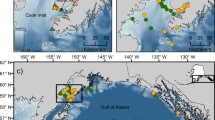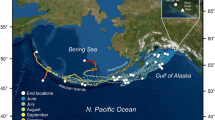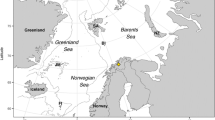Abstract
Chinook salmon are widely distributed in offshore waters of the North Pacific Ocean, and of great economical and subsistence importance; however, little is known about their oceanic ecology. To address this, we tagged 43 Chinook salmon Oncorhynchus tshawytscha (57–100 cm) with pop-up satellite archival tags (PSATs) in the eastern (October– December) and central Bering Sea (August) to provide insights into the oceanic movements, behavior, and thermal environment of this species. The tags retrieved data for up to 260 days and end locations of tagged Chinook salmon spanned from the central Bering Sea (n = 6), eastern Bering Sea/Aleutian Islands (n = 20), and the Gulf of Alaska (n = 6). While at liberty, Chinook salmon occupied depths ranging from 0 to 538 m and experienced a thermal environment ranging from −0.6 to 13.5 °C. Overall, mean depths of individual fish ranged from 4.5 to 127.9 m, while median depths ranged from 1.3 to 99.5 m. Although sample sizes were not even among months of the year, Chinook salmon occupied the shallowest and warmest water in May–September and the deepest and coolest water in December–March. Diel depth-specific diving behaviors of Chinook salmon were found in some tag records, but these behaviors appeared to be variable among individuals and plastic in nature within individuals. Results from this study provide insights into movement, diving behavior and the thermal environment of individual Chinook salmon which may have future application in understanding its ecology and developing strategies to further reduce incidental catch of this species.






Similar content being viewed by others
References
Adams J, Kaplan IC, Chasco B, Marshall KN, Acevedo-Gutiérrez A, Ward EJ (2016) A century of Chinook salmon consumption by marine mammal predators in the Northeast Pacific Ocean. Ecol Inform 34:44–51. https://doi.org/10.1016/j.ecoinf.2016.04.010
ADF&G (2013) Chinook salmon stock assessment and research plan, 2013. Alaska department of fish and game. Anchorage, Alaska
Arkhipkin AI, Bizikov VA, Verkhunov AV (1998) Distribution and growth in juveniles of the squid Berryteuthis magister (Cephalopoda, Gonatidae) in the western Bering Sea. Sarsia 83:45–54. https://doi.org/10.1080/00364827.1998.10413668
Arnold G, Dewar H (2001) Electronic tags in marine fisheries research: a 30-year perspective. In: Sibert JR, Nielsen JL (eds) Electronic tagging and tracking in marine fisheries. Kluwer Academic Publishers, Dordrecht, pp 7–64. https://doi.org/10.1007/978-94-017-1402-0_2
Arostegui MC, Essington TE, Quinn TP (2017) Interpreting vertical movement behavior with holistic examination of depth distribution: a novel method reveals cryptic diel activity patterns of Chinook salmon in the Salish Sea. Anim Biotelemetry 5. https://doi.org/10.1186/s40317-016-0116-5
Béguer-Pon M, Benchetrit J, Castonguay M, Aarestrup K, Campana SE, Stokesbury MJW, Dodson JJ (2012) Shark predation on migrating adult American eels (Anguilla rostrata) in the Gulf of St. Lawrence PLoS ONE 7:e46830. https://doi.org/10.1371/journal.pone.0046830
Braun CD, Skomal GB, Thorrold SR, Berumen ML (2015) Movements of the reef manta ray (Manta alfredi) in the Red Sea using satellite and acoustic telemetry. Mar Biol 162:2351–2362. https://doi.org/10.1007/s00227-015-2760-3
Braun CD, Galuardi B, Thorrold SR (2018) HMMoce: an R package for improved geolocation of archival-tagged fishes using a hidden Markov method. Methods Ecol Evol 9:1212-1220. https://doi.org/10.1111/2041-210X.12959
Brodeur RD et al (2000) A coordinated research plan for estuarine and ocean research on Pacific salmon. Fisheries 25:7–16. https://doi.org/10.1577/1548-8446(2000)025<0007:ACRPFE>2.0.CO;2
Chasco B et al (2017) Estimates of Chinook salmon consumption in Washington state inland waters by four marine mammal predators from 1970 to 2015. Can J Fish Aquat Sci 74:1173–1194. https://doi.org/10.1139/cjfas-2016-0203
Computers W (2015) Data portal’s location processing (GPE3 & FastLoc-GPS) user guide. Wildlife Computes, Inc, Redmond, Washington
Courtney MB, Scanlon BS, Rikardsen AH, Seitz AC (2016) Utility of pop-up satellite archival tags to study the summer dispersal and habitat occupancy of Dolly Varden in Arctic Alaska. Arctic 69:137-146 doi:https://doi.org/10.14430/arctic4561
Davis ND, M-a F, Armstrong JL, Myers KW (2005) Salmon food habits studies in the Bering Sea, 1960 to present. N Pac Anadromous Fish Comm Tech Rep 6:24–28
Davis ND, Myers KW, Fournier WJ (2009a) Winter food habits of Chinook salmon in the eastern Bering Sea. N Pac Anadromous Fish Comm Bull 5:243–253
Davis ND, Volkov AV, Efimkin AY, Kuznetsova NA, Armstrong JL, Sakai O (2009b) Review of BASIS salmon food habits studies. N Pac Anadromous Fish Comm Bull 5:197–208
Drenner SM, Clark TD, Whitney CK, Martins EG, Cooke SJ, Hinch SG (2012) A synthesis of tagging studies examining the behaviour and survival of anadromous salmonids in marine environments. PLoS One 7:e31311. https://doi.org/10.1371/journal.pone.0031311
Ford JKB, Ellis GM, Barrett-Lennard LG, Morton AB, Palm RS, Balcomb KC III (1998) Dietary specialization in two sympatric populations of killer whales (Orcinus orca) in coastal British Columbia and adjacent waters. Can J Zool 76:1456–1471. https://doi.org/10.1139/z98-089
Gisclair BR (2009) Salmon bycatch management in the Bering Sea walleye Pollock fishery: threats and opportunities for western Alaska. In: Krueger CC, Zimmerman CE (eds) Pacific salmon: ecology and management of westem Alaska's populations American fisheries society, symposium 70. Bethesda, Maryland, pp 799–816
Healey MC (1991) Life history of Chinook salmon (Oncorhynchus tshawytscha). In: Groot C, Margolis L (eds) Pacific salmon life histories. University of British Columbia Press, Vancouver, pp 313–393
Hedger RD, Rikardsen AH, Strøm JF, Righton DA, Thorstad EB, Næsje TF (2017a) Diving behaviour of Atlantic salmon at sea: effects of light regimes and temperature stratification. Mar Ecol Prog Ser 574:127–140. https://doi.org/10.3354/meps12180
Hedger RD, Rikardsen AH, Thorstad EB (2017b) Pop-up satellite archival tag effects on the diving behaviour, growth and survival of adult Atlantic salmon Salmo salar at sea. J Fish Biol 90:294–310. https://doi.org/10.1111/jfb.13174
Hinke JT, Foley DG, Wilson C, Watters GM (2005a) Persistent habitat use by Chinook salmon Oncorhynchus tshawytscha in the coastal ocean. Mar Ecol Prog Ser 304:207–220. https://doi.org/10.3354/meps304207
Hinke JT, Watters GM, Boehlert GW, Zedonis P (2005b) Ocean habitat use in autumn by Chinook salmon in coastal waters of Oregon and California. Mar Ecol Prog Ser 285:181–192. https://doi.org/10.3354/meps285181
Hobday AJ, Hartog JR, Timmiss T, Fielding J (2010) Dynamic spatial zoning to manage southern bluefin tuna (Thunnus maccoyii) capture in a multi-species longline fishery. Fish Oceanogr 19:243–253. https://doi.org/10.1111/j.1365-2419.2010.00540.x
Honakalehto T, McCarthy A (2015) Results of the acoustic-trawl survey of walleye Pollock (Gadus chalcogrammus) on the U.S. and Russian Bering Sea shelf in June - august 2014 (DY1407). Alaska fisheries science center, National Marine Fisheries Service, Seattle, Washington
Honkalehto T, McCarthy A, Lauffenburger N (2018) Results of the acoustic-trawl survey of walleye Pollock (Gadus chalcogrammus) on the U.S. Bering Sea shelf in June - august 2016 (DY1608). Alaska fisheries science center, National Marine Fisheries Service, Seattle, Washington
Ianelli JN, Stram DL (2015) Estimating impacts of the Pollock fishery bycatch on western Alaska Chinook salmon. ICES J Mar Sci 72:1159–1172. https://doi.org/10.1093/icesjms/fsu173
Keating KA (1995) Mitigating elevation-induced errors in satellite telemetry locations. J Wildl Manag 59:801–808. https://doi.org/10.2307/3801960
Lacroix GL (2014) Large pelagic predators could jeopardize the recovery of endangered Atlantic salmon. Can J Fish Aquat Sci 71:343–350. https://doi.org/10.1139/cjfas-2013-0458
Larson WA et al (2013) Single-nucleotide polymorphisms reveal distribution and migration of Chinook salmon (Oncorhynchus tshawytscha) in the Bering Sea and North Pacific Ocean. Can J Fish Aquat Sci 70:128–141. https://doi.org/10.1139/cjfas-2012-0233
Madsen S, Haflinger K (2016) Chinook salmon bycatch reduction incentative plan. Report to National Marine Fisheries Service
Murphy JM, Heard WR (2001) Chinook salmon data storage tag studies in Southeast Alaska, 2001. N Pac Anadromous Fish Comm Doc 555:1–21
Murphy JM, Heard WR (2002) Chinook salmon data storage tag studies in Southeast Alaska, 2002. N Pac Anadromous Fish Comm Doc 632:1–16
Musyl MK et al (2011) Performance of pop-up satellite archival tags. Mar Ecol Prog Ser 433:1–28. doi.org/10.3354/meps09202
Myers KW, Rogers DE (1988) Stock origins of Chinook salmon in incidental catches by groundfish fisheries in the eastern Bering Sea. N Am J Fish Manag 8:162–171. https://doi.org/10.1577/1548-8675(1988)008<0162:SOOCSI>2.3.CO;2
Myers KW, Walker RV, Davis ND, Armstrong JL, Kaeriyama ME (2009) High seas distribution, biology, and ecology of Arctic–Yukon–Kuskokwim salmon: direct information from high seas tagging experiments. In: Krueger CC, Zimmerman CE (eds) Pacific salmon: ecology and management of westem Alaska's populations vol 70. American Fisheries Society, Bethseda, pp 1954–2006
Myers KW, Irvine JR, Logerwell EA, Urawa S, Naydenko SV, Zavolokin AV, Davis ND (2016) Pacific salmon and steelhead: life in a changing winter ocean. N Pac Anadromous Fish Comm Bull 6:113-138 doi:https://doi.org/10.23849/npafcb6/113-138
NPFMC (2008) Draft environmental impact statement for Bering Sea/Aleutian Islands Chinook salmon bycatch management. North Pacific fisheries management council. Anchorage, Alaska
NPFMC (2016) Bering Sea Chinook salmon and chum salmon bycatch management measures North Pacific fishery management council. Anchorage, Alaska
Pedersen MW (2010) Hidden Markov modelling of movement data from fish. Technical University of Denmark
Putman NF et al (2014) An inherited magnetic map guides ocean navigation in juvenile Pacific salmon. Curr Biol 24:446–450. https://doi.org/10.1016/j.cub.2014.01.017
Quinn TP (2005) The behavior and ecology of Pacific salmon and trout. University of Washington Press, Seattle
Riddle BE et al (2018) Ocean ecology of Chinook salmon. In: Beamish RJ (ed) The ocean ecology of Pacific salmon and trout. America Fisheries Society, Bethsed, pp 555–696
Sato S, Sato T, Nakamura T, Seitz A, Suzuki K (2015) The summer 2014 Japanese salmon research cruise of the R/V Hokko maru. N Pac Anadromous Fish Comm Doc 1640:1–16
Schindler D et al (2013) Arctic-Yukon-Kuskokwim Chinook salmon research action plan: evidence of decline of Chinook salmon populations and recommendations for future research. Prepared for the AYK sustainable salmon. Initiative, Anchorage
Seitz AC, Courtney MB, Evans MD, Manishin K (2019) Pop-up satellite archival tags reveal evidence of intense predation on large immature Chinook salmon (Oncorhynchus tshawytscha) in the North Pacific Ocean. Can J Fish Aquat Sci https://doi.org/10.1139/cjfas-2018-0490
Smedbol RK, Wroblewski JS (2002) Metapopulation theory and northern cod population structure: interdependency of subpopulations in recovery of a groundfish population. Fish Res 55:161–174. https://doi.org/10.1016/S0165-7836(01)00289-2
Stabeno PJ, Schumacher JD, Ohtani K (1999) The physical oceanography of the Bering Sea. In: Thomas TL, Ohtani K (eds) Dynamics of the Bering Sea: a summary of physical, chemical, and biological characteristics, and a synopsis of research on the Bering Sea. University of Alaska Sea Grant, Fairbanks, pp 1–28
Stabeno PJ, Bond NA, Kachel NB, Salo SA, Schumacher JD (2001) On the temporal variability of the physical environment over the south-eastern Bering Sea. Fish Oceanogr 10:81–98. https://doi.org/10.1046/j.1365-2419.2001.00157.x
Stabeno PJ, Danielson SL, Kachel DG, Kachel NB, Mordy CW (2016) Currents and transport on the eastern Bering Sea shelf: an integration of over 20 years of data. Deep-Sea Res II Top Stud Oceanogr 134:13–29. https://doi.org/10.1016/j.dsr2.2016.05.010
Stram DL, Ianelli JN (2009) Eastern Bering Sea Pollock trawl fisheries: variation in salmon bycatch over time and space. In: Krueger CC, Zimmerman CE (eds) Pacific salmon: ecology and management of westem Alaska's populations. American fisheries society, symposium 70. Bethesda, Maryland, pp 827–850
Stram DL, Ianelli JN (2015) Evaluating the efficacy of salmon bycatch measures using fishery-dependent data. ICES J Mar Sci 72:1173–1180. https://doi.org/10.1093/icesjms/fsu168
Strøm JF, Rikardsen AH, Campana SE, Righton D, Carr J, Aarestrup K, Stokesbury MJW, Gargan P, Javierre PC, Thorstad EB (2019) Ocean predation and mortality of adult Atlantic salmon. Sci Rep. https://doi.org/10.1038/s41598-019-44041-5
Strøm JF, Thorstad EB, Chafe G, Sørbye SH, Righton D, Rikardsen AH, Carr J (2017) Ocean migration of pop-up satellite archival tagged Atlantic salmon from the Miramichi River in Canada. ICES J Mar Sci 74:1356–1370. https://doi.org/10.1093/icesjms/fsw220
Strøm JF, Thorstad EB, Hedger RD, Rikardsen AH (2018) Revealing the full ocean migration of individual Atlantic salmon. Anim Biotelemetry 6:2. https://doi.org/10.1186/s40317-018-0146-2
Thorstad EB, Rikardsen AH, Alp A, Økland F (2013) The use of electronic tags in fish research–an overview of fish telemetry methods. Turk J Fish Aquat Sci 13:881–896. https://doi.org/10.4194/1303-2712-v13_5_13
Thygesen UH, Pedersen MW, Madsen H (2009) Geolocating fish using hidden Markov models and data storage tags. In: Nielsen JL, Arrizabalaga H, Fragoso N, Hobday A, Lutcavage M, Sibert J (eds) Tagging and tracking of marine animals with rlectronic devices. Springer, Neverlands, pp 277–293
Trudel M et al (2009) Distribution and migration of juvenile Chinook salmon derived from coded wire tag recoveries along the continental shelf of western North America. Trans Am Fish Soc 138:1369–1391. https://doi.org/10.1577/T08-181.1
Wahlberg M, Westerberg H, Aarestrup K, Feunteun E, Gargan P, Righton D (2014) Evidence of marine mammal predation of the European eel (Anguilla anguilla L.) on its marine migration. Deep Sea Res, Part I 86:32–38. https://doi.org/10.1016/j.dsr.2014.01.003
Walker RV, Myers KW (2009) Behavior of Yukon River Chinook salmon in the Bering Sea as inferred from archival tag data. N Pac Anadromous Fish Comm Bull 5:121–130
Walker RV, Sviridov VV, Urawa S, Azumaya T (2007) Spatio-temporal variation in vertical distributions of Pacific salmon in the ocean. N Pac Anadromous Fish Comm Bull 4:193–201
Walli A et al (2009) Seasonal movements, aggregations and diving behavior of Atlantic bluefin tuna (Thunnus thynnus) revealed with archival tags. PLoS One 4:e6151. https://doi.org/10.1371/journal.pone.0006151
Weitkamp LA (2010) Marine distributions of Chinook salmon from the west coast of North America determined by coded wire tag recoveries. Trans Am Fish Soc 139:147–170. https://doi.org/10.1577/T08-225.1
Wilson SG, Block BA (2009) Habitat use in Atlantic bluefin tuna Thunnus thynnus inferred from diving behavior. Endanger Species Res 10:355–367
Acknowledgements
This project was supported by the Arctic-Yukon-Kuskokwim Sustainable Salmon Initiative and the Pollock Conservation Cooperative Research Center at the University of Alaska Fairbanks. Additional in-kind support was provided by National Marine Fisheries Service-Alaska Fisheries Science Center, NETS Seattle, and the Fisheries Research Agency of Japan. We thank Dave Magone, Debbie Brown, Parker Bradley, Nicholas Smith, Kristin Neuneker, and Nate Cathcart for their help during winter tagging operations. We thank Shigehiko Urawa and Shunpei Sato of the Hokkaido National Fisheries Research Institute, and the captain and crew of the R/V Hokko maru for their help and generosity during summer tagging fieldwork. Koji Tamura of NETS Seattle enabled us to transport a 750 lb. metal box across the Pacific Ocean, not once, but twice. Finally, we thank Robert Walker and Kate Myers, both retired, of the former University of Washington High-Seas Salmon Research Program and Jim Murphy of the National Oceanic and Atmospheric Administration for their valuable insights into all phases of this research project.
Author information
Authors and Affiliations
Corresponding author
Additional information
Publisher’s note
Springer Nature remains neutral with regard to jurisdictional claims in published maps and institutional affiliations.
Electronic supplementary material
ESM 1
(DOCX 21 kb)
Rights and permissions
About this article
Cite this article
Courtney, M.B., Evans, M.D., Strøm, J.F. et al. Behavior and thermal environment of Chinook salmon Oncorhynchus tshawytscha in the North Pacific Ocean, elucidated from pop-up satellite archival tags. Environ Biol Fish 102, 1039–1055 (2019). https://doi.org/10.1007/s10641-019-00889-0
Received:
Accepted:
Published:
Issue Date:
DOI: https://doi.org/10.1007/s10641-019-00889-0




